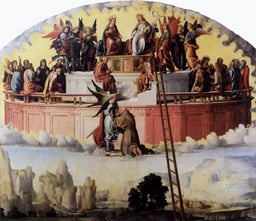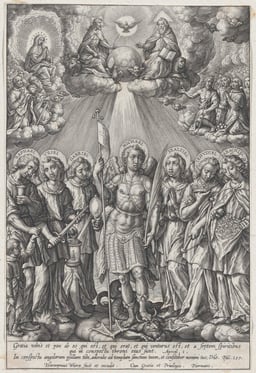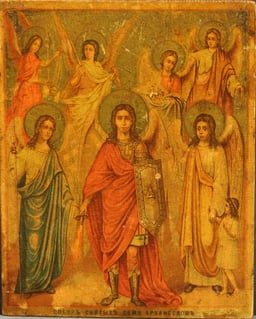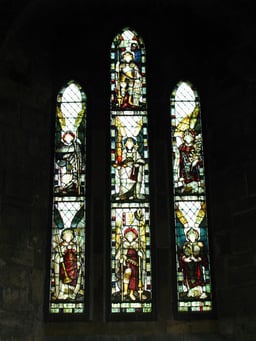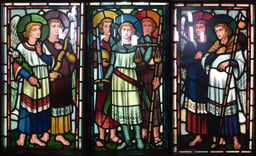Seven Archangels

Seven Archangels
The concept of Seven Archangels is found in some works of early Jewish literature.
Bible
The term archangel itself is not found in equivalent in the Hebrew Bible, and in the Greek New Testament the term archangel only occurs in 1 Thessalonians 4:16 and the Epistle of Jude 1:9, where it is used of Michael, who in Daniel 10:13 is called 'one of the chief princes,' and 'the great prince'. In the Septuagint this is rendered "the great angel."[1]
Tobit
The idea of seven archangels is most explicitly stated in the deuterocanonical Book of Tobit when Raphael reveals himself, declaring: "I am Raphael, one of the seven angels who stand in the glorious presence of the Lord, ready to serve him." (Tobit 12:15) The other two archangels mentioned by name in the Bible are Michael and Gabriel. The four names of the other archangels come from tradition.
1 Enoch
One such tradition of archangels comes from the Old Testament Jewish apocrypha, namely the third century BCE Book of the Watchers,[2] which eventually merged with four other books in what has been called the Enochic Pentateuch, but which is commonly known today as 1 Enoch, or the Book of Enoch.[3][4] The Enoch story's narrative is affiliated with the Book of Giants, which also references the great archangels[5][6] and was made part of the Ethiopian Orthodox Tewahedo Church's scriptural canon. Although by the seventh century it was rejected by Christian leaders from all other denominations as canonical scripture, and despite having been prevalent in Jewish and early Christian apostolic traditions (as well as the early Christian leaders writings), the book fell from academic and religious status (i.e., failing to 'qualify' in the eyes of church authorities as canonical scripture) — resulting in the text not being found in most parts of the world, as it was forbidden, from the 7th century C.E. on. The list of angels survived only as part of oral traditions that differed to one another depending on the particular religio-cultural tradition in which they were present, and thus many different lists of angels (termed "archangel") exist, but to different levels of acceptance.
The Jewish people borrowed the names for angels from the Babylonian culture,[7] which under the dualistic influence of Zoroastrianism, and as an addition to its own development of early Mesopotamian belief systems, had resulted in a folklore and cosmology that centered around the anthropomorphic and zoomorphic representation of stars and planets, in which it was later introduced the same concept for star constellations, whose characteristics and names were imported by notable Jewish prophets during their forced exile known as the Babylonian captivity starting in 605 BCE, first with the prophet Daniel, then later with authors such as Ezekiel who styled the Babylonian constellations (the abstract forms of the constellations), that were held as "sons of the gods" (the four sons of the Sky Father deity in Babylonia that carried the Winged Sun, the throne of the Wisdom), as angels from the Lord of Israel, in fact living animals in the heaven that were referred to as cherubim, and with that he repurposed some of the characters found in the Mesopotamian polytheistic belief system as angelic servants of the Lord of Israel, thus establishing the prevalence of the God of Israel. The 2 BC Book of the Parables, chapter XL, echoes such folkloric representations, and gives the name of the four angels with whom the Ancient of Days comes, the ones standing before the Lord of Spirits, "the voices of those upon the four sides magnifying the Lord of Glory" as: Michael, Raphael, Gabriel, and Phanuel.
From the Book of the Watchers chapter IX, a list of group of angels is given, in this case, the ones who saw the quantity of blood which was shed on earth in account of the transgression of the "sons of the gods", a group of rogue celestial spirits, termed "the Watchers", that arrived to earth during the antediluvian times, and it is given as a group of five that interceded on behalf of humankind to the Most High: Michael, Gabriel, Raphael, and Uriel. Whereas the most popular tradition was borrowed from chapter XX, in which a list of "seven angels who watch" is given as: Uriel, Raphael, Raguel, Michael, Sarakiel, Gabriel, and Remiel.
Christian traditions
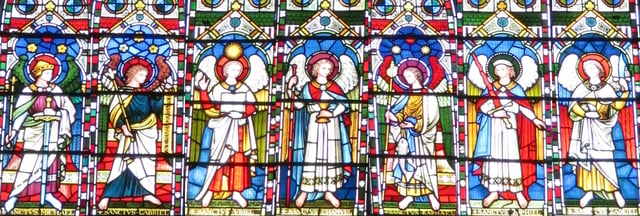
Seven Archangels as given by Pseudo-Dionysius depicted in the stained glass window at St Michael's Church, Brighton. From left: Michael, Gabriel, Uriel, Chamuel (Camael), Raphael, Jophiel, and Zadkiel.
The earliest specific Christian references are in the late 5th to early 6th century: Pseudo-Dionysius gives them as Michael, Gabriel, Raphael, Uriel, Camael, Jophiel, and Zadkiel.[8] Pope Gregory I lists them as Michael, Gabriel, Raphael, Uriel (or Anael), Simiel, Oriphiel, and Raguel. In most Protestant Christian oral traditions only Michael and Gabriel are referred to as "archangels", which echoes the most mainstream Muslim view on the subject, whereas in the Roman Catholic Christian traditions Raphael is also included, resulting in a group of three.
Lists of characters referred to as "angels" also exist in traditions foreign to the largest religious groups, and are usually regarded as occultist or superstitious. A later reference to seven archangels appeared in an 8th or 9th-century talisman attributed to Auriolus, a "servant of God" in north-western Spain. He issues a prayer to "all you patriarchs Michael, Gabriel, Cecitiel, Oriel, Raphael, Ananiel, Marmoniel.[9]
Archangels in current church traditions
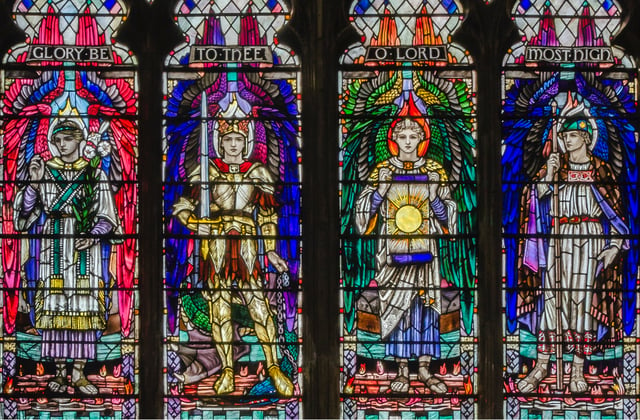
The four archangels in Anglican tradition, from left to right: Gabriel, Michael, Uriel, and Raphael. Stained glass window at Hull Minster.
In the Catholic Church, three archangels are mentioned by name in its canon of scripture: Michael, Gabriel, and Raphael. Raphael appears in the deuterocanonical Book of Tobit, where he is described as "one of the seven angels who stand ready and enter before the glory of the lord of spirits",[10] a phrase recalled in Revelation 8:2–6 [28] .
Some strands of the Eastern Orthodox Church, exemplified in the Orthodox Slavonic Bible (Ostrog Bible, Elizabeth Bible, and later consequently Russian Synodal Bible), recognize as authoritative also 2 Esdras, which mentions Uriel. The Eastern Orthodox Church and Eastern Catholic Churches of the Byzantine tradition, venerate seven archangels and sometimes an eighth. Michael, Gabriel, Raphael, Uriel, Selaphiel (Salathiel), Jegudiel (Jehudiel), Barachiel, and the eighth, Jerahmeel (Jeremiel) (The Synaxis of the Chief of the Heavenly Hosts, Archangel Michael and the Other Heavenly Bodiless Powers: Feast Day: November 8).[11]
As well as Uriel, the Book of Enoch, not regarded as canonical by any of these Christian churches, mentions (chapter 21) Raguel, Sariel, and Jerahmeel, while other apocryphal sources give instead the names Izidkiel, Hanael, and Kepharel.[12]
Other ideas
Although in the Book of Enoch, Ramiel is described as one of the leaders of the 200 Grigori, the fallen angels, the leader is identified as Semjaza. Other names derived from pseudepigrapha and recognized by Eastern Orthodox and Oriental Orthodox churches are Selaphiel, Jegudiel, and Raguel.
In Ismailism, there are seven cherubim, comparable to the Seven Archangels ordered to bow down before Qadar, of whom Iblis refuses.[22]
In Yazidi religion, there are seven archangels, named Jabra'il, Mika'il, Rafa'il (Israfil), Dadra'il, Azrail and Shamkil (Shemna'il) and Azazil, who are emanations from God and entrusted to care about the created world.[23]
Seven angels or archangels are given as related to the seven days of the week: Michael (Sunday), Gabriel (Monday), Raphael (Tuesday), Uriel (Wednesday), Selaphiel (Thursday), Raguel or Jegudiel (Friday), and Barachiel (Saturday).
Various occult systems associate each archangel with one of the traditional "seven luminaries" (the seven naked-eye moving objects in the sky: the seven classical planets): the sun, the moon, Mercury, Venus, Mars, Jupiter, and Saturn;[24] but there is disagreement as to which archangel corresponds to which body. Regardless, each day of week has a name of a celestial body. Monday is Moon day. Tuesday is Mars. Wednesday is Mercury. Thursday is Jupiter. Friday is Venus. Saturday is Saturn. Sunday is the Sun.
According to Rudolf Steiner, four important archangels also display periodic spiritual activity over the seasons: Spring is Raphael, summer is Uriel, autumn is Michael, and winter is Gabriel.[25] Following this line of reasoning, Aries (astrologically ruled by Mars) represents spring, Cancer (ruled by the moon) represents summer, Libra (ruled by Venus) represents autumn, and Capricorn (ruled by Saturn) represents winter. Therefore, by association, Raphael is Mars, Uriel is the moon, Michael is Venus, and Gabriel is Saturn. Rudolf Steiner's Northern Hemisphere indications regarding the seasons and their placement in the Zodiac will be the opposite in the Southern Hemisphere, making Michael the Mars archangel – with autumn in Aries; Raphael the Venus archangel – with spring in Libra; Gabriel connected to the long, moonlit nights of winter in Cancer; and Uriel linked to Saturn, presiding over bright summer days in Capricorn.
